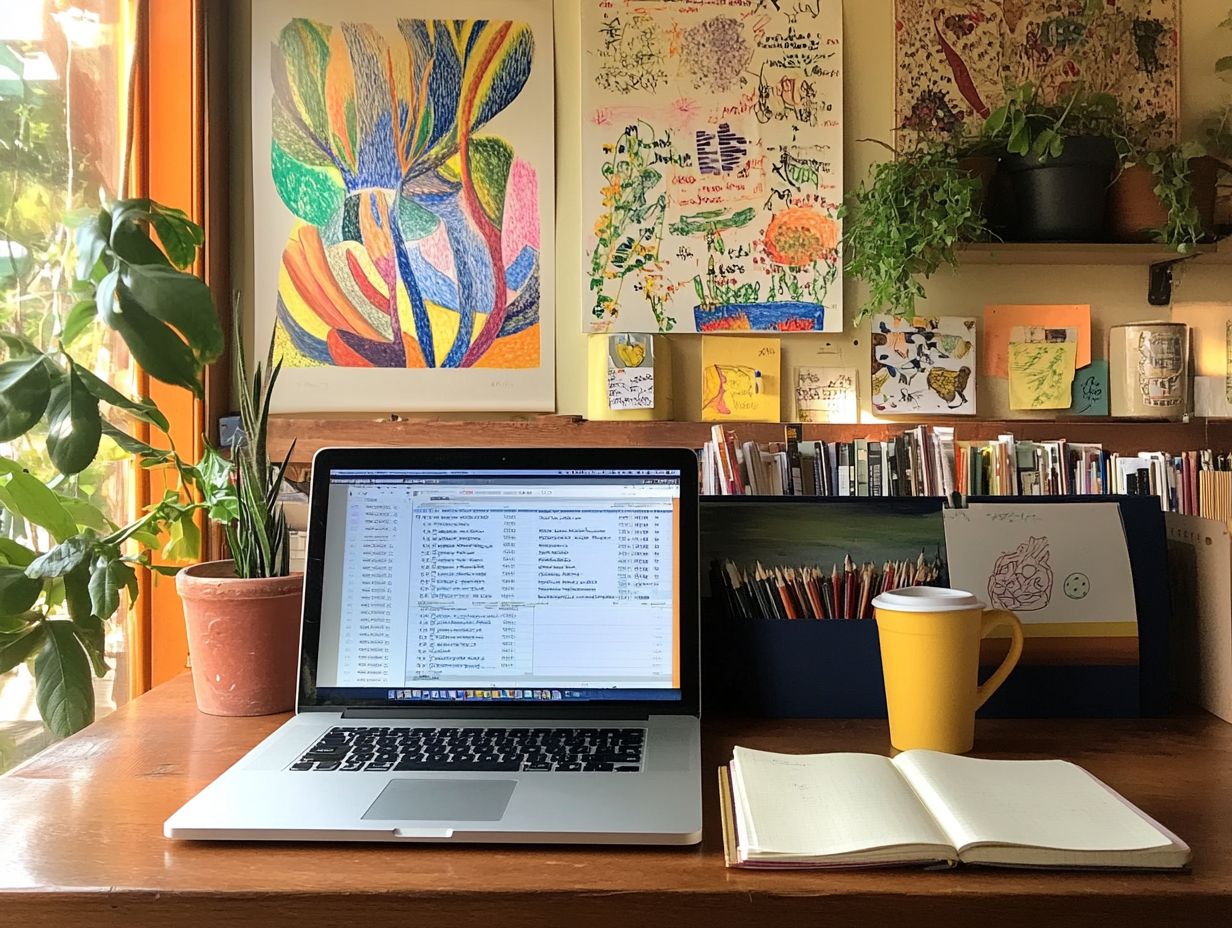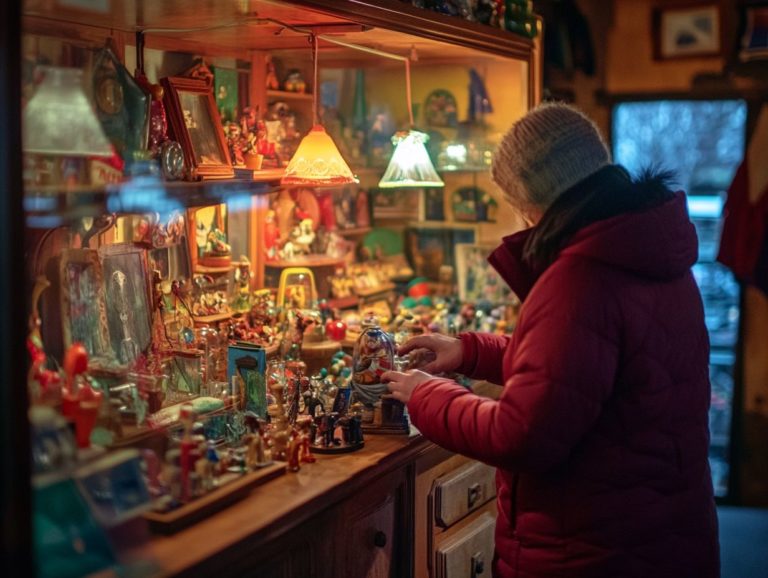How to Create a Collectible Art Database
In today s digital landscape, managing your art collection can feel like a thrilling adventure, yet it can also be a bit overwhelming. A well-organized collectible art database not only preserves the value of your pieces but also enhances your enjoyment and understanding of your collection.
This guide will walk you through the essential steps for creating your own database, from choosing the right platform to entering detailed information about each piece. You ll explore best practices for data maintenance, sharing options, and privacy considerations, ensuring your valuable art is meticulously documented and secure.
Jump in now and see how a collectible art database can transform your collecting journey!
Contents
- Key Takeaways:
- The Importance of a Collectible Art Database
- Creating Your Own Database
- Organizing Your Data
- Collecting and Entering Data
- Types of Information to Include
- Best Practices for Data Entry
- Managing and Updating Your Database
- Sharing Your Database
- Frequently Asked Questions
- Q1: What is a collectible art database?
- Q2: Why should I create a collectible art database?
- Q3: How do I create a collectible art database?
- Q4: What information should I include in a collectible art database?
- Q5: How do I maintain and update my collectible art database?
- Q6: Are there any online resources for creating a collectible art database?
Key Takeaways:

Keeping track of your collectible art is crucial – a database helps you organize your collection effectively. To begin, you might want to explore how to start a collectible art portfolio. Choose a suitable platform and organize your data in a consistent and accessible format to make data entry and updates easier. Include relevant information and backup your database regularly to ensure your collection remains up-to-date and secure.
The Importance of a Collectible Art Database
A collectible art database is critical for art collectors aiming to manage and showcase their unique collections with finesse. This helpful tool not only preserves the details of each artwork but also tracks exhibition history and restoration services, enriching your understanding of every piece.
For you, maintaining organized records is crucial, especially when handling valuable items that require careful records and protection. In today s digital landscape, harnessing technology to create a robust database enables you to navigate gallery exhibitions and auction platforms effortlessly, elevating your engagement with the art community.
Why You Need a Database for Your Collection
For art collectors like you, having a dedicated database is essential for effective inventory management. It enables you to track exhibitions seamlessly and gain valuable financial insights.
An organized system not only assists in cataloging your pieces but also provides important data on market trends, enabling you to make well-informed purchase decisions.
This digital documentation promotes clarity, giving you a comprehensive view of your collection s worth over time while also protecting against potential losses or misplacements. A robust inventory system simplifies the sales process, ensuring smooth transactions whether you’re at auctions or engaging in private sales.
By incorporating features like valuation updates and history of ownership (provenance) records, you can maintain the integrity and value of your collection in today s technology-driven art market.
Creating Your Own Database
Establishing your own database for managing a unique art collection enables you to curate customizable galleries that truly reflect your personal tastes and preferences.
By leveraging modern technology, such as an AI Website Builder, you can significantly streamline the website design process, creating a user-friendly platform that enhances your overall experience in managing your art collection.
This approach offers not just a tailored solution but also facilitates the integration of advanced techniques for data organization and presentation, ultimately fostering a more engaging interaction with your artworks.
Choosing a Platform
Choosing the right platform for your art database is crucial, as it directly influences the functionality, security, and overall user experience of your art collection software.
Consider scalability, ease of integration, and user interface simplicity when choosing a platform. It’s essential to prioritize security features in your decision-making to safeguard your valuable artworks and sensitive data against potential breaches.
Use performance optimizations, like Cloudflare CDN, to improve loading times, ensuring a seamless experience for users accessing your database. These considerations not only boost management efficiency but also enhance the accessibility and visibility of your unique art collection, facilitating greater engagement for curators and collectors alike.
Start building your art database now to safeguard your collection and enhance your experience!
Organizing Your Data

Organizing your data is essential. It maximizes your art database’s potential by capturing and managing artwork details.
A well-structured inventory system is key. This system integrates digital documents with artwork management tools.
By implementing best practices, such as categorizing artworks by type, medium, or artist, you can streamline access. This enhances retrieval efficiency.
Customizable reports enable insightful analyses. They ensure your specific data needs are met. These reports can spotlight trends, identify inventory needs, or trace the history of each piece, elevating your overall organization.
Digital documentation helps you maintain a comprehensive history of each artwork. This simplifies collection management for curators and collectors alike.
Collecting and Entering Data
Collecting and entering data into your art database is vital! This process guarantees that all pertinent information about your collection is carefully noted and readily accessible.
As an art collector, understanding the diverse types of information to include like artwork inventory details, certification of authenticity, and financial insights can streamline your documentation.
By establishing a clear protocol for data entry, you can cultivate an organized digital archive. This archive captures the rich history and intrinsic value of your unique art collection.
Types of Information to Include
When creating your art database, it s crucial to include various information for a comprehensive perspective on each piece. This should encompass detailed descriptions, including dimensions, mediums, and history, including where it came from.
Showcasing artist portfolios highlights their creative journeys and provides context for their work. This helps potential buyers make informed decisions.
Including an exhibition history that outlines past displays further enriches the narrative. Detailed notes on restoration services can reassure buyers about the piece’s condition.
Together, these elements create a robust inventory that enhances engagement with auction platforms and exhibitions. This fosters vibrant dialogue between artists and collectors.
Best Practices for Data Entry
Implementing best practices for data entry is essential for maintaining your art database’s integrity and reliability. This is especially true when using art management software that provides automated hosting.
By ensuring consistency in your data input, each entry aligns with defined parameters. This greatly facilitates accurate searches and retrieval.
Prioritizing accuracy is crucial. It minimizes the risk of errors that could disrupt your entire inventory system. Timely updates become essential.
Security practices must be at the forefront of your strategy. Safeguarding sensitive information is vital, as digital documentation presents potential vulnerabilities.
When you diligently follow these best practices, you enhance the management of your collections significantly. This allows artists, galleries, and auction houses to operate seamlessly, free from common pitfalls associated with disorganized data.
Managing and Updating Your Database
Regularly managing and updating your art database is essential for keeping your inventory system current and functional. This diligence allows you to track exhibition history and maintain comprehensive client lists.
Stay organized and efficient in your art dealings by keeping your database up to date!
Regular Maintenance and Backups

Regular maintenance and backups are crucial for managing your art database. They protect against security breaches and data loss while preserving the integrity of your digital documentation.
To enhance the longevity and reliability of your database, consider using automated hosting solutions that make the process easier. By setting up scheduled backups and detailed lists of your items, you can track changes effortlessly and access previous versions of your data.
These practices boost your data security and improve operational efficiency, enabling real-time updates and seamless recovery in case of unforeseen issues.
By integrating automated tools, you create a proactive environment that allows you to focus on your creativity while ensuring the safety of your invaluable collections.
Tracking Changes and Updates
Tracking changes and updates within your art database is essential for maintaining accurate records and gaining financial insights into your collection.
By implementing effective exhibition tracking and creating customizable reports, you can gain a clearer understanding of the performance and status of each piece. These tools streamline keeping track of your collection and facilitate assessments that shape your future purchasing and sales strategies.
For instance, when an artwork moves to a new exhibition, documenting those changes keeps the chain of ownership and exhibition history transparent. This detail significantly helps in appraising the value of your collection over time, encouraging a more strategic approach to your art investments.
Sharing Your Database
Sharing your art database can enhance collaboration and elevate visibility for art collectors. However, it s essential to consider privacy and security implications to safeguard sensitive digital documents.
Balancing accessibility with protection is crucial in this digital age, ensuring that your valuable information remains secure while fostering an environment of shared creativity and opportunity.
Options for Sharing with Others
You have many options for sharing your art collection, from online platforms to gallery exhibitions and auction sites. These avenues boost your visibility and accessibility while cultivating a vibrant community where you can interact with artists and fellow collectors.
Online platforms like artsy.com and saatchiart.com allow you to showcase your portfolio, making it easier to connect with potential buyers or collaborators who appreciate your taste.
By integrating artist portfolios into auction platforms, you create excitement and competition that enables you to support emerging talents while accessing exclusive collections. Utilizing these digital spaces lets you dive into lively discussions about exhibitions and share insights on emerging trends, ultimately enhancing your experience in the art world.
Privacy and Security Considerations
When sharing your art database, prioritizing privacy and security measures is vital to safeguard your valuable digital documentation from potential breaches. This protection matters for artists, collectors, and galleries alike, as sensitive information may include ownership details and transaction records.
Use automated hosting services that prioritize data security to lower risks. Tools like Cloudflare offer enhanced encryption and constant monitoring against cyber threats.
Implementing strict access controls and user permissions establishes an additional layer of defense. By adopting these best practices, you protect your assets and foster a trustworthy environment within the art community.
This creates a space for seamless information sharing without putting proprietary data at risk.
Frequently Asked Questions

Q1: What is a collectible art database?
A collectible art database is a digital system that organizes and stores information about collectible artwork. This includes details like the artist, title, year created, and type of material used.
Q2: Why should I create a collectible art database?
A collectible art database helps you track your art collection effectively. It ensures that everything is documented and organized properly!
Q3: How do I create a collectible art database?
You can create your collectible art database using a spreadsheet or specialized software. For more insights, check out the basics of collectibles and art. Choose the method that suits your needs and skills best.
Q4: What information should I include in a collectible art database?
Include essential details like the artist’s name, title of the artwork, date created, and dimensions. Adding photos or scanned images is also helpful.
Q5: How do I maintain and update my collectible art database?
Regularly review and update your database to keep it accurate. Set aside time to add new pieces and update information.
Q6: Are there any online resources for creating a collectible art database?
Yes! Many online platforms offer tools and templates for your art database. Research options that fit your needs best.






